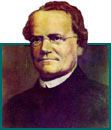Throughout the nineteenth century, heredity remained a puzzle to scientists. How was it that children ended up looking similar to, but not exactly like, their parents? These questions fascinated and frustrated Charles Darwin deeply. After all, heredity lies at the heart of evolution. The variations in each generation are the raw material for natural selection, while the continuity from one generation to the next allows the changes wrought by natural selection to have long-term effects. Darwin himself proposed that each cell in an animal’s body released tiny particles that streamed to the sexual organs, where they combined into eggs or sperm. They would then blend together when the animal mated. But “pangenesis,” as Darwin called it, didn’t hold up to scrutiny.

Ironically, it was just as Darwin was publishing the Origin of Species that someone got the first real glimpse of the biological machinery behind heredity. In a secluded monastery in what is now the Czech Republic, a monk named Gregor Mendel was studying heredity in a garden of peas. Mendel, the son of a farmer, had always been interested in plants, and while at the University of Vienna he had been trained in mathematics and learned how to design experiments and analyze data. In the 1850s, he decided to run an experiment to better understand what kept species distinct and what made it possible for hybrids to form. He bred thousands of pea plants and recorded how traits were passed on from one generation to the next.
Trait inheritance
 Mendel selected 22 different varieties of peas and interbred them, keeping track of seven different traits, such as pea texture — smooth or wrinkled. Mendel found that when he hybridized smooth and wrinkled peas, he produced peas that were all smooth. But if he then produced a new generation of peas from the hybrids, a quarter of the peas were wrinkled.
Mendel selected 22 different varieties of peas and interbred them, keeping track of seven different traits, such as pea texture — smooth or wrinkled. Mendel found that when he hybridized smooth and wrinkled peas, he produced peas that were all smooth. But if he then produced a new generation of peas from the hybrids, a quarter of the peas were wrinkled.
Mendel proposed that the peas were not blending their “wrinkled” and “smooth” traits together. Each hybrid pea inherited both traits, but only the smooth trait became visible. In the next generation, the traits were handed down again, and a quarter of the new peas inherited two “wrinkled” traits, which made them wrinkled. Mendel had discovered what later scientists called “dominant” and “recessive” alleles.
Mendel’s work goes unrecognized

Mendel tried to drum up interest in his results but to no avail. Part of the problem was that botanists of Mendel’s time were not accustomed to statistics being applied to natural history, and so they couldn’t recognize the importance of Mendel’s discovery. And when Mendel tried to replicate his results with hawkweed, he failed — not because his original insights were wrong, but because the genetics of hawkweed are very peculiar. Nevertheless, the patterns that Mendel saw did apply to many organisms and were there in nature for anyone to see. Darwin himself noted a three-to-one ratio in the colors of snapdragons. But for all his genius, Darwin didn’t realize the importance of that ratio.
Mendel abandoned his experiments in the 1860s and turned his attentions to running his monastery. When he died in 1884, he was remembered as a puttering monk with a skill for breeding plants. It was only some 15 years after his death that scientists realized that Mendel had revealed the answer to one of life’s greatest mysteries.
